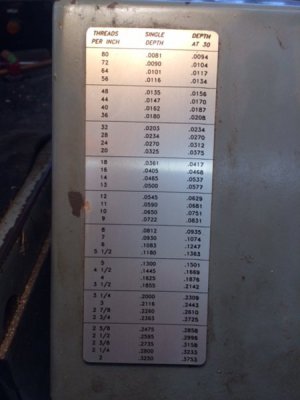Mach, cutting threads depends on the class of fit you require. If you simply need to make a one-off and don't care about class then get close as Cathead and the others said and cut until the nut fits. When doing this, it helps to coat the blank with a Sharpie so you can see the thread form better and start test fitting when a small flat appears on the thread. Spring passes help to refine the fit.
On the other hand, you can also cut the thread to a class of fit. An external thread is an "A" thread, while an internal thread is a "B" thread, and there are three general classes - 1, 2 and 3. An external class 1a is a loose fit, a class 2a is the normal fit we see with 90% of manufactured threaded stuff, and class 3a is a close tolerance fit. Cutting an external thread to the tolerances of a class allows any nut of that class to fit. For example, if you cut a class 2a thread then any hardware store nut will likely fit it fine. So, you need to determine what class of fit you are going for and cut it that way. To do this, you need a thread micrometer or a 3-wire set.
While it might seem more cumbersome to do it this way, it is actually simpler for me because I just cut until I get the micrometer reading I want and stop; no test fitting or wondering. On the off chance that it will help, I'm attaching the best threading chart I've seen; it includes all the information you need to cut any class of internal or external thread you need. You do need that 3-wire set or thread mic to use it but you should have these tools anyway if you ever plan to do a precision thread.
If you look at the chart for a 1/4-24 class 2a thread, you will see that you need to cut the blank to an OD of 0.2489 to 0.2417". Use your regular mic to hit somewhere inside this range. Then start thread cutting and start checking the thread pitch with the thread mic or wires when the peaks start to form. You want to cut until the thread pitch falls inside the range of 0.2218 - 0.2181". When you get there, stop and you're done. A thread mic is far faster and simpler to use for this because it is direct reading and simple to use with the part in the lathe. You don't worry about formulas this way and if you hit the pitch diameter range, the thread will fit. You can also use go/no-go gauges but that gets expensive. A 3-wire set (cumbersome) or a thread mic is cheaper. This one will work:
http://www.shars.com/0-1-screw-thread-micrometer
I think most of us start out with the formulas and the cut and fit method but eventually we will need to make precision threads for some project and it is a good idea to teach yourself how to produce one.

